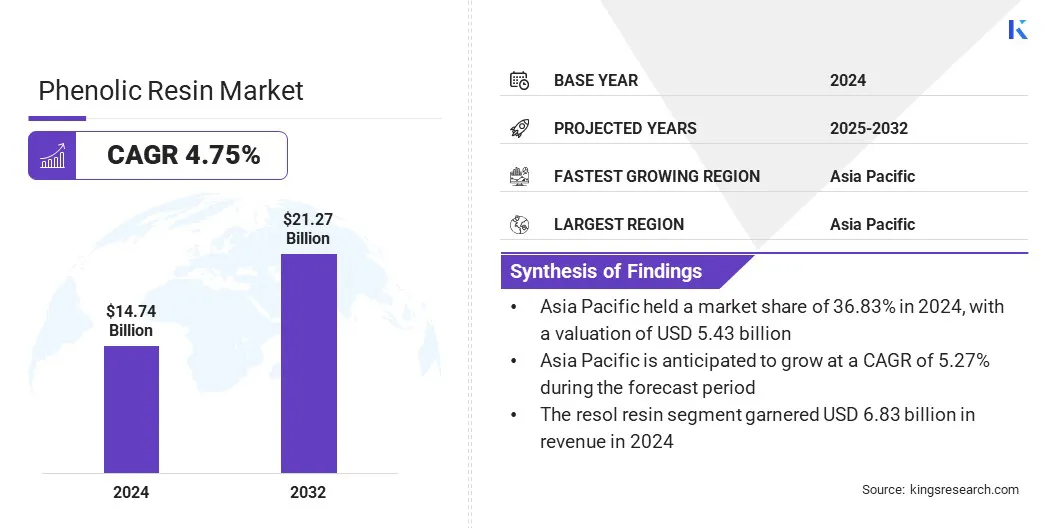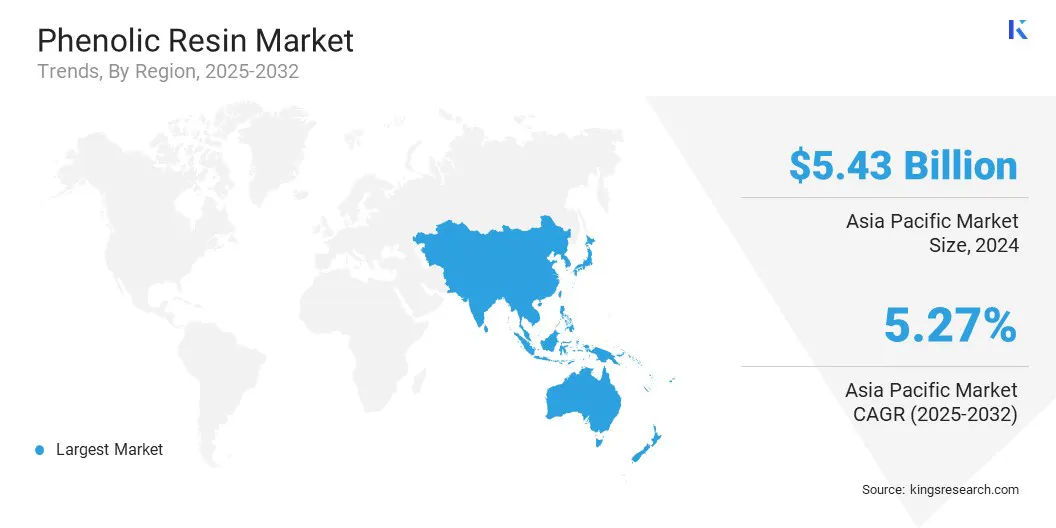enquireNow
Phenolic Resin Market
Phenolic Resin Market Size, Share, Growth & Industry Analysis, By Product Type (Resol Resin, Novolac Resin, Others), By Application (Wood Adhesives/Binders, Molding Compounds, Laminates, Coatings, Others), By End-use Industry (Building & Construction, Automotive & Transportation, Electrical & Electronics), and Regional Analysis, 2025-2032
pages: 160 | baseYear: 2024 | release: August 2025 | author: Sunanda G.
Market Definition
Phenolic resin is a synthetic polymer created through the reaction of phenol with formaldehyde, forming a thermosetting material with strong adhesive and heat-resistant qualities. It exhibits superior mechanical strength, chemical stability, and thermal insulation properties.
The market spans automotive, aerospace, electronics, and construction sectors, where durable composite materials are required. Manufacturers apply phenolic resin in coatings, molded parts, brake linings, laminates, and insulation panels to enhance fire resistance, structural integrity, and longevity in demanding environments.
The global phenolic resin market size was valued at USD 14.74 billion in 2024 and is projected to grow from USD 15.37 billion in 2025 to USD 21.27 billion by 2032, exhibiting a CAGR of 4.75% during the forecast period.
The market is growing due to the rising adoption in moisture-resistant wood products like plywood and MDF, where strong bonding and durability are essential. Additionally, the increasing demand for low-emission and bio-based resin formulations, driven by environmental regulations and sustainability goals is encouraging manufacturers to innovate and expand their product offerings.
Key Highlights
- The phenolic resin industry size was valued at USD 14.74 billion in 2024.
- The market is projected to grow at a CAGR of 4.75% from 2025 to 2032.
- Asia Pacific held a market share of 36.83% in 2024, with a valuation of USD 5.43 billion.
- The resol resin segment garnered USD 6.83 billion in revenue in 2024.
- The wood adhesives/binders segment is expected to reach USD 7.33 billion by 2032.
- The building & construction segment secured the largest revenue share of 37.43% in 2024.
- Europe is anticipated to grow at a CAGR of 4.91% during the forecast period.
Major companies operating in the phenolic resin market are Hexion Inc., Sumitomo Bakelite Co., Ltd., BASF, DIC Corporation, Kolon Industries, Inc., SI Group, Inc., Ashland Global Holdings Inc., Kangnam Chemical, Shandong Laiwu Runda New Material Co., Ltd., Akrochem Corporation, Allnex GmbH, Bakelite Synthetics, ASK Chemicals GmbH, Hexcel Corporation, and Fenolit d.d.

Phenolic Resin Market Report Snapshot
|
Segmentation |
Details |
|
By Product Type |
Resol Resin, Novolac Resin, Others |
|
By Application |
Wood Adhesives/Binders, Molding Compounds, Laminates, Coatings, Others |
|
By End-use Industry |
Building & Construction, Automotive & Transportation, Electrical & Electronics, Furniture, Others |
|
By Region |
North America: U.S., Canada, Mexico |
|
Europe: France, UK, Spain, Germany, Italy, Russia, Rest of Europe | |
|
Asia-Pacific: China, Japan, India, Australia, ASEAN, South Korea, Rest of Asia-Pacific | |
|
Middle East & Africa: Turkey, U.A.E., Saudi Arabia, South Africa, Rest of Middle East & Africa | |
|
South America: Brazil, Argentina, Rest of South America |
Phenolic Resin Market Regional Analysis
Based on region, the market has been classified into North America, Europe, Asia Pacific, Middle East & Africa, and South America.
The Asia Pacific phenolic resin market share stood at 36.83% in 2024, with a valuation of USD 5.43 billion. This dominance is attributed to Asia Pacific’s well-established industrial manufacturing base, particularly in sectors such as automotive components, electronics, and heavy machinery.
Phenolic resins are extensively used in applications like brake linings, clutch facings, circuit boards, and insulation components, owing to their high heat resistance and structural integrity. The continued growth of industrial clusters and export-driven manufacturing hubs across the region is further fueling the demand for these resins.
- In March 2024, Sumitomo Bakelite Co., Ltd. expanded its phenolic resin production capacity at its manufacturing plant in Japan to meet the rising demand from the automotive and electronics sectors. The expansion aims to support growing industrial clusters in Asia Pacific that focus on export-driven manufacturing and require materials with high heat resistance and structural durability.

The phenolic resin industry in Europe is poised for a CAGR of 4.91% over the forecast period. Market growth is primarily driven by stringent fire safety regulations that mandate the use of flame-retardant materials in public infrastructure, high-rise buildings, and mass transit systems.
Phenolic resins are widely adopted in insulation foams, composite panels, and coatings due to their superior fire resistance and low smoke emissions. The increasing focus on fire-rated and safety-compliant materials has led to the greater demand for phenolic resin-based solutions in Europe’s construction industry.
Phenolic Resin Market Overview
Rising demand from the construction and automotive sectors is driving the widespread adoption of phenolic resins. In the building industry, phenolic resins are used in laminates, insulation materials, and structural panels due to their excellent fire resistance and mechanical strength.
The automotive sector is incorporating phenolic resins into brake pads, clutch plates, and under-the-hood components to withstand high temperatures and harsh operating conditions. These materials offer chemical stability, dimensional integrity, and thermal performance that meet the safety and durability standards of both industries. Manufacturers are opting for phenolic resins to improve product reliability and extend service life in demanding environments.
Market Driver
Increasing Adoption in Moisture-Resistant Wood Products
Phenolic resins play a key role in the wood products industry due to their strong and moisture-resistant bonding capabilities. These resins are widely used in the production of plywood, medium-density fiberboard (MDF), and particleboard, where durability and structural integrity are essential.
In decorative laminates, phenolic resins provide dimensional stability, surface hardness, and resistance to heat and chemicals. Their ability to form long-lasting bonds under high-pressure and high-temperature conditions makes them ideal for engineered wood applications. Leading furniture manufacturers and construction firms are relying on phenolic resins to enhance product longevity and performance in variable environmental conditions.
- In December 2024, researchers at the Hunan City University (China) developed a larch‑tannin–modified phenol–formaldehyde (LTPF) resin for plywood production. The LTPF‑U‑4 resin achieved a bonding strength of 1.09 MPa, exceeding the minimum requirement of 0.70 MPa for Class I plywood under China’s GB 17657‑2013 standard. It also met E0 formaldehyde emission levels, making it suitable for engineered wood applications in furniture and construction.
Market Challenge
Feedstock Price Volatility Creating Margin Pressure
A key challenge in the phenolic resin market is reliance on petroleum-based feedstocks such as phenol and formaldehyde, which are subject to significant price fluctuations. This dependency is introducing cost unpredictability and complicating financial planning for manufacturers. Volatile input costs are affecting profit margins and the competitiveness of phenolic resins in price-sensitive applications.
To address this challenge, market players are diversifying their supplier base, exploring bio-based feedstock alternatives, and implementing cost-control strategies across the production cycle. Companies are also optimizing manufacturing processes to improve yield and reduce waste, helping offset the impact of feedstock volatility.
Market Trend
Focus on Low‑Emission & Bio‑Based Resin Formulations
A key trend in the phenolic resin market is the increasing focus on low-emission and bio-based resin formulations. Manufacturers are developing low-formaldehyde and modified resin types to reduce volatile organic compound (VOC) emissions during production and use.
Bio-based phenolic resins derived from renewable feedstocks are also gaining traction as alternatives to petroleum-derived variants. These developments are helping industries meet stricter environmental regulations and corporate sustainability goals. Performance requirements are also being maintained while offering improved safety and environmental compatibility.
- In December 2024, Michelin Resicare unveiled its “araminolic” sugar-based phenolic resin at Paris. The resin is derived from beet sucrose and wheat or maize fructose and is designed to replace traditional phenol–formaldehyde resins. It offers comparable performance in moisture resistance, rigidity, and mechanical strength, while reducing petrochemical dependency and formaldehyde emissions.
Market Segmentation
- By Product Type (Resol Resin, Novolac Resin, and Others): The resol resin segment earned USD 6.83 billion in 2024, due to its superior thermal stability, faster curing properties, and widespread use in high-volume applications such as insulation, adhesives, and molded components.
- By Application (Wood Adhesives/Binders, Molding Compounds, Laminates, Coatings, and Others): The wood adhesives/binders segment held 37.44% of the market in 2024, attributed to its widespread use in moisture-resistant and high-strength applications like plywood, MDF, and particleboard.
- By End-use Industry (Building & Construction, Automotive & Transportation, Electrical & Electronics, Furniture, and Others): The building & construction segment is projected to reach USD 8.10 billion by 2032, owing to the material’s superior fire resistance, thermal insulation, and structural strength.
Regulatory Frameworks
- In the U.S., phenolic resin manufacturing is regulated under the National Emission Standards for Hazardous Air Pollutants (NESHAP) by the Environmental Protection Agency (EPA), which targets formaldehyde, phenol, and methanol emissions. Additionally, the Toxic Substances Control Act (TSCA) Title VI governs formaldehyde emission standards for composite wood products, which require third-party certification and product labeling.
- The European Union enforces phenolic resin regulations through REACH (Registration, Evaluation, Authorisation and Restriction of Chemicals), which requires companies to register and control hazardous substances like formaldehyde. Products containing over 0.05% formaldehyde must be labeled, and workplace exposure is tightly controlled.
- In China, phenolic resin regulations are shaped by the Environmental Protection Tax Law, which penalizes high-emission manufacturers and has led to stricter controls on formaldehyde and phenol discharges. Fire safety standards like GB 8624–2012 classify building materials by flame retardance, boosting the use of phenolic insulation. Additionally, China RoHS (Restriction of Hazardous Substances) regulates resin use in electronics, requiring labeling and control over toxic substances in compliance with national safety norms.
- Japan regulates phenolic resins through the Building Standards Act, which mandates fire-resistant materials for public and residential structures, driving the demand for phenolic-based insulation. The Chemical Substances Control Law (Kashinhō) governs chemical registration, classification, and monitoring, requiring phenolic resins to be listed in the Existing and New Chemical Substances (ENCS) database. This framework aligns with the Globally Harmonized System (GHS), ensuring consistent labeling and hazard communication for all resin-based products.
Competitive Landscape
Major players in the phenolic resin industry are investing in research and development (R&D), forming partnerships and introducing sustainable products to remain competitive. These approaches help companies respond to the growing demand for environmentally friendly alternatives, particularly in high-performance applications like automotive components.
By focusing on advanced formulations and using renewable feedstocks, manufacturers are positioning themselves to meet stricter environmental regulations and rising customer expectations.
- In June 2025, Sumitomo Bakelite introduced the world’s first commercially available solid novolac-type lignin-modified phenolic resin derived from non-edible biomass. Featuring 15% bio-based content, the resin has been adopted in automotive casting applications since early 2024 and delivers approximately 11% lower greenhouse gas emissions compared to conventional phenolic resins.
Key Companies in Phenolic Resin Market:
- Hexion Inc.
- Sumitomo Bakelite Co., Ltd.
- BASF
- DIC Corporation
- Kolon Industries, Inc.
- SI Group, Inc.
- Ashland Global Holdings Inc.
- Kangnam Chemical
- Shandong Laiwu Runda New Material Co., Ltd.
- Akrochem Corporation
- Allnex GmbH
- Bakelite Synthetics
- ASK Chemicals GmbH
- Hexcel Corporation
- Fenolit d.d.
Recent Developments (Expansion)
- In October 2024, Sumitomo Bakelite expanded its liquid phenolic resin supply capacity at SNC Industrial Laminates in Malaysia. The facility now serves Southeast Asia, Southwest Asia, and Oceania, enabling a more stable regional supply chain. The expansion supports increased demand in circuitry and laminate applications across the region.
freqAskQues
